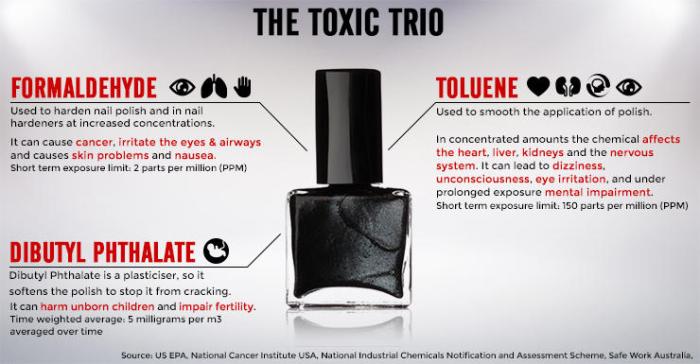Nail Polish Stinks A Comprehensive Look
The Science and Scents of Nail Polish

Source: housetrick.com
Nail polish stinks – Nail polish, a seemingly simple cosmetic, boasts a complex chemical composition that directly impacts its characteristic odor. This odor, while sometimes pleasant to some, can be a significant source of concern for others, ranging from mild annoyance to severe allergic reactions. This article delves into the science behind nail polish scent, exploring its chemical makeup, associated health risks, consumer perceptions, industry practices, and available alternatives.
Chemical Composition and Odor
The distinctive smell of nail polish primarily stems from its volatile organic compounds (VOCs). These VOCs, which readily evaporate at room temperature, include solvents like ethyl acetate, butyl acetate, and acetone, responsible for the quick drying process. Resins, such as nitrocellulose, contribute to the polish’s film-forming properties and also influence the overall scent. The type and proportion of these components vary considerably across different nail polish types.
Gel polishes, for example, often contain higher concentrations of specific resins and photoinitiators, leading to a potentially stronger, distinct odor compared to regular nail polishes. Water-based nail polishes, conversely, rely on water as the primary solvent, resulting in a significantly milder, often less pungent aroma. The volatility of these ingredients directly correlates with odor intensity; more volatile compounds release their scent more readily.
Health and Safety Concerns
Prolonged exposure to nail polish fumes can present various health risks. Symptoms can range from mild eye, nose, and throat irritation to more severe issues like headaches, dizziness, and nausea. Allergic reactions, manifested as skin rashes, contact dermatitis, or respiratory problems, are also possible. To minimize inhalation, adequate ventilation is crucial during application and removal. Using nail polish remover in a well-ventilated area, or even outdoors, significantly reduces exposure.
Furthermore, wearing a mask can further protect against inhalation.
| Ingredient | Toxicity Level | Health Effects | Safety Precautions |
|---|---|---|---|
| Acetone | Moderate | Eye, nose, and throat irritation; headaches; dizziness | Use in well-ventilated areas; avoid prolonged exposure; wear gloves |
| Toluene | High | Nervous system effects; respiratory irritation; skin irritation | Avoid inhalation; wear gloves and a mask; use in well-ventilated areas |
| Formaldehyde | High | Allergic reactions; respiratory problems; cancer (in high concentrations) | Choose formaldehyde-free polishes; ensure good ventilation |
| Dibutyl phthalate (DBP) | Moderate | Reproductive toxicity (in high concentrations); skin irritation | Choose DBP-free polishes |
Consumer Perceptions and Experiences, Nail polish stinks
Many consumers express negative experiences with the strong smell of nail polish. These range from mild annoyance to significant discomfort, particularly in individuals with sensitivities or allergies. Common complaints include headaches, nausea, and respiratory irritation. Manufacturers can address these concerns by developing and marketing formulations with reduced VOC content, utilizing milder solvents, and incorporating natural fragrances or scent masking agents.
- Develop and market “low-odor” or “odorless” nail polish formulations.
- Utilize natural, less pungent solvents and resins.
- Implement stricter quality control measures to minimize variations in scent.
- Clearly label ingredients and potential health implications on product packaging.
Industry Practices and Regulations
Regulations concerning VOCs in nail polish vary across regions. Many countries are implementing stricter standards to reduce air pollution and protect consumer health. Manufacturers are responding by developing and marketing lower-odor formulations, often labeled as “3-free,” “5-free,” or “7-free,” indicating the absence of specific harmful chemicals. These efforts are driven by both consumer demand and environmental regulations.
A hypothetical consumer education campaign could involve informative videos, social media awareness campaigns, and collaborations with dermatologists and healthcare professionals to highlight the potential health implications of nail polish ingredients.
Alternative Nail Polish Options
Several alternatives offer a less pungent experience. Water-based polishes, for instance, have a significantly milder odor than traditional solvent-based options. “3-free,” “5-free,” and “7-free” polishes exclude various common VOCs and other potentially harmful chemicals. Nail wraps and temporary nail tattoos are also odorless alternatives, offering a convenient and long-lasting manicure without the chemical smell.
- Water-based nail polishes: Generally have a very faint or almost imperceptible odor.
- 3-Free polishes: Exclude formaldehyde, toluene, and DBP.
- 5-Free polishes: Also exclude camphor and formaldehyde resin.
- 7-Free polishes: Often exclude additional ingredients like ethyl tosylamide and xylene.
- Nail wraps: Odorless application and removal.
- Temporary nail tattoos: Odorless and easy to apply.
Methods for Reducing or Masking the Smell

Source: dailyhealthpost.com
Minimizing exposure to nail polish fumes is key. Applying nail polish in a well-ventilated area, using a fan or opening windows, significantly reduces the concentration of VOCs. Employing odor-absorbing materials like activated charcoal filters or air purifiers can further help to neutralize the smell. While masking the smell with essential oils or scented candles might seem appealing, it’s crucial to prioritize safety and ensure that these additions don’t trigger allergic reactions or create new health hazards.
FAQ Resource: Nail Polish Stinks
Can nail polish cause headaches?
Yes, the strong fumes from some nail polishes can trigger headaches in sensitive individuals due to the volatile organic compounds (VOCs) they contain.
Are all “3-free” nail polishes truly odorless?
No, while “3-free” polishes (free of formaldehyde, toluene, and dibutyl phthalate) often have a milder odor than traditional polishes, they may still have a detectable scent due to other ingredients.
How can I dispose of old nail polish safely?
Check with your local waste management authority for guidelines. Many areas have specific disposal methods for hazardous waste, which may include nail polish.
Let’s be honest, the smell of nail polish can be quite pungent; some find it intensely unpleasant. However, the intensity of that smell often depends on how many coats you apply; to achieve the desired opacity, you might need to consider the advice given in this helpful article on how many layers of nail polish. Ultimately, fewer layers mean less exposure to those potentially headache-inducing fumes.
Is it safe to use nail polish while pregnant?
While there’s no definitive evidence linking nail polish use to birth defects, many pregnant women opt for low-odor or water-based alternatives to minimize potential exposure to chemicals.
















